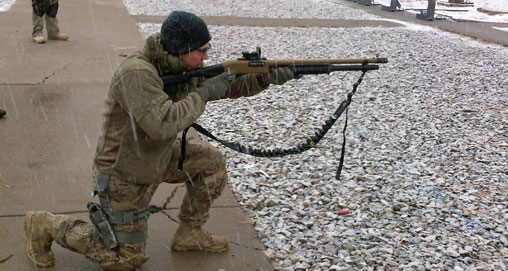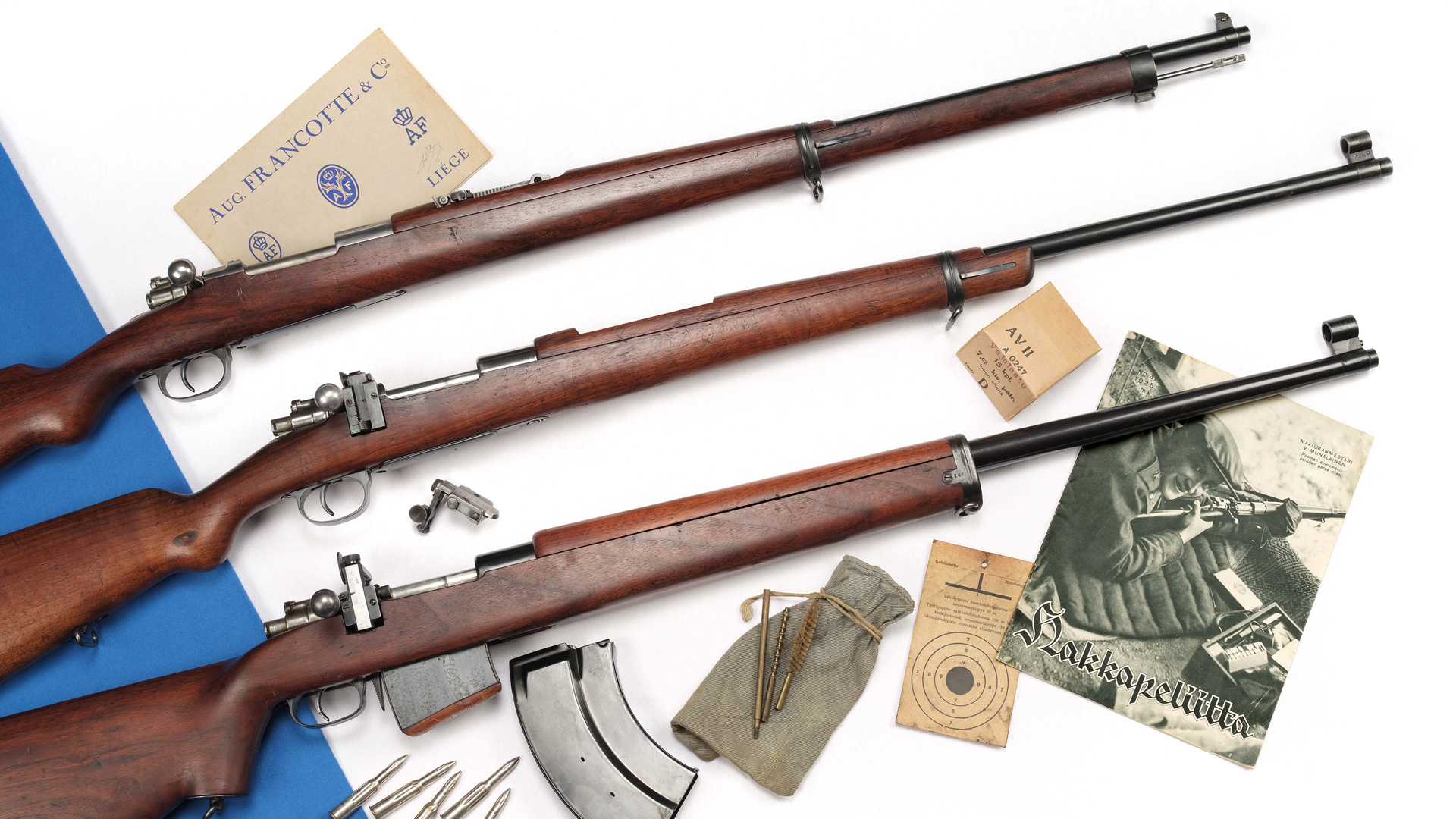
Established in 2001, the Counter Terrorism Institute of America (CTIA) provides armed citizens with access to the same training usually reserved for members of law enforcement and the military. Combining decades of experience from a broad array of shooting backgrounds, the staff of CTIA offers high-level defensive handgun, rifle and shotgun instruction. The instructors for this class were Rich Clawson, a 14-year law enforcement veteran, and CTIA Director Dennis Kennedy.
CTIA provides a true, come-as-you-are learning environment in its Urban Shotgun course. No specific gear or gun configuration is required to have a successful learning experience. The instructors approach the class as a kind of laboratory. What better place than in the safety of a closed range, and with the assistance of a professional instructor, to find out if your gear, gun and ammunition combination will work well or break down in a defensive situation?
Gearing up
In preparing for the course, I chose one of Mossberg's reliable 500 pump-action shotguns. Mossberg pumps and semi-autos were well represented, as were Remington 870s and 1187s. Pistol-grip-only shotguns, made popular in action films, were not represented in the class or by the instructors. This is because they are not practical defensive tools since they cannot be properly aimed. A standard shoulder stock or the now-popular AR style six-position collapsible stocks with a pistol grip are far superior choices. While any handgun that's a logical choice for home and self-defense was welcome, shooters favored 1911 and GLOCK platforms in 9 mm, 40 S&W and .45 ACP carried in strong-side holsters.
Support gear plays an important role in training as well. I turned to BLACKHAWK! for knee pads, elbow pads, a heavy belt, dump pouch, shotgun sling and cold weather shooting gloves. All of this gear worked well and proved to be invaluable during the training session—especially the gloves. Uncle Mike's Reflex Holster was ideal for the transitions from shotgun to handgun. With no buttons or levers to fuss with, the Reflex made drawing the handgun effortless, while keeping it secure during movement on the course. The choice to use Winchester ammunition paid off. The shot shells—including birdshot, buckshot and slug configurations—and handgun cartridges all functioned and fired reliably.
Defensive Shotgun Patterns
Starting at just 3 yards, the class fired birdshot loads into fixed targets. Hollywood often depicts scatter guns blowing dinner-plate sized holes through walls and doors at close range. In reality, defensive shotguns with 18- to 20-inch barrels produce much tighter patterns. The rule of thumb, as explained by the instructors, is 1 inch of pattern spread for every yard of distance from the target. Sure enough, at 3 yards, the variety of shotguns on the line presented 3-inch holes in their respective targets. At 7 yards, the birdshot patterns opened up to around 7 inches, and at 15 yards, birdshot covered the standard targets from side to side. This rule of thumb also held true for buckshot loads.
Why is it important to understand how defensive shotguns pattern? First, it explains why shotguns work so well as defensive tools. The destructive saturation effect of hundreds of birdshot pellets, or a cluster of buckshot, striking a target at close range is a nearly irresistible stopping force. Another, important reason for understanding the pattern is to emphasize the need for well-aimed shots. Shotguns are not flame throwers, filling a room with destructive energy. In fact, the closer the home defender is to the target, the smaller the shot pattern will be, thus making it harder to hit the target.
Combat Loading for Shotguns
The primary weaknesses of the shotgun as a defensive tool are its low ammunition capacity and relatively slow loading speed. Most pump and semi-auto 12-gauge shotguns hold between four and nine rounds of ammunition, and the rounds usually have to be fed into the gun one at a time. With this in mind, the heart of CTIA's Urban Shotgun training is focused on mastering the combat loading process. You would think loading a shotgun would be simple, until you add the fact that your eyes must be off of your hands and firearm to focus on the threat, and the loading steps must be completed while on the move. For the sake of simplicity, the rest of this description will assume the shooter is using his or her right hand as the shooting hand, the left hand as the support hand and that the loading/ejection port of the shotgun is located on the right side of the receiver.
Students learn that a combat load starts with the shotgun stock pressed to the shoulder and the shotgun aimed in the direction of the threat using the shooting hand. The support hand, which also operates the shotgun slide or bolt, is used to retrieve and load fresh shells. The support hand can travel over the top of the receiver or under the receiver to load the shell. Both methods are correct and a matter of the shooter's preference. The benefit of going under the receiver is the shooter's view of the threat is not blocked by the movement of the support hand.
Sport shooters often hold a shotshell like a pencil, using the thumb, index and middle finger, as the first shell is fed into the shotgun with the shooting hand. However, for combat loading, the shell is positioned with the index and little fingers holding the ends of the shell. The middle and ring fingers are poised to support the center of the shell and press it into the loading/ejection port.
This method of holding the shell allows for critical by-touch indexing. If the support hand is traveling under the receiver, the shooter should feel the crimp of the shell against the index finger and the metallic shell base against the little finger. If loading over the top, the crimp is against the little finger and the base against the index finger. This manual indexing ensures the shell is facing the correct direction as it enters the shotgun.
To conduct a combat load, the chamber is opened by pulling back the slide (pump-action) or bolt handle (semi-auto). One round is combat loaded, or "slapped" into the loading/ejection port, the bolt is closed by pulling the slide forward or by pressing the bolt release button. With the first round combat loaded into the chamber, the shotgun is ready to fire, or to have additional rounds fed into the magazine. Once students started to move through the obstacle courses, the combat loading method proved to be the fastest way to get an empty shotgun back into action. As the pace picked up even more, there were times when combat loading was used exclusively to keep the gun in the exercise as each shell was fired as soon as the chamber was closed.
Firearm Transitions
It was during this portion of the class that students put their shotgun slings and holstered handguns to work. These skills are taught and practiced because, under certain circumstances, it is more effective to engage the threat by transitioning to a handgun instead of reloading a shotgun. Bandolier shotgun slings proved to be heavy when loaded with shells, in turn pulling the muzzle of the shotgun off target. A better choice for carrying extra ammunition is a hard, polymer side saddle fitted to the receiver or stock of the shotgun.
Single-point slings allowed students to essentially lay their shotguns against their bodies and let go of their long gun as they drew their pistols. Traditional two-point slings, the most common type for sporting guns, also proved to be useful with a bit of practice. As the shotgun runs dry, or malfunctions, the shooter uses his or her support hand to grasp the sling where it attaches to the shoulder stock, lifting the stock up and over the head with the sling looping around the body. As the shotgun is slung, the shooting hand draws the handgun from the holster. If no sling is attached to the shotgun, then the shooter can hug the shotgun to the body with the support arm while the shooting hand draws and fires the handgun.
Embrace the Weather
One of the benefits of indoor target shooting, from a training perspective, is that it strips away the annoying environmental conditions that get in the way of making nice, neat marks on the paper. CTIA, on the other hand, follows an all-weather training model, meaning the weather that happens to be on hand for the day of class is invited to participate as yet another instructor on the range. This particular training event, located up a canyon at an outdoor shooting range, started off cold and cloudy. As the day wore on, it rained, sleeted and snowed. By the time students started running the final obstacle courses in the afternoon, the wind had picked up and the early day rain had turned into ice.
Mark Twain once said, “If you hold a cat by the tail you learn things you cannot learn any other way.” This is also true with tactical training conducted in wet, freezing weather. It’s uncomfortable stripping ice out of a shotgun’s action between drills, but very instructive. Here are a few of the lessons brought to bear by Old Man Winter:
•If shooters use electronic sight systems, they should have iron sights in place as a backup. In this case, holographic sights clogged with snow and ice, or they conked out from the cold. Although rifle sights and ghost-ring sight systems are effective, the traditional single-bead shotgun sight can be used quite effectively for placing fast, accurate shots at close range, as well as for making long-range shots with slugs. The key is to create a sight picture in which the bead is level with the top of the receiver.
•In the harshest weather conditions I'm likely to face, the Mossberg shotgun, Winchester ammunition and Sentry Solutions lubricants I have on hand are going to function properly. Some lubricants can get gummy in cold weather and cause malfunctions, so shooters need to ensure they are using the right products for their geography.
•All of the benefits and weaknesses of each student’s support gear was amplified by the weather. Ammunition retention systems, gloves and gear that worked well before the weather turned nasty were also useful in the cold. Those that were already hard to work with or malfunctioning only became more of a problem.
•Properly executed loading, shooting and footwork techniques really do work, especially when the ground is slick, fingers are numb and the mind is tired. That's why the military and law enforcement use these systems in the first place.
Final Thoughts
Nothing in the world can replace live fire training conducted by professional instructors. The Counter Terrorism Institute of America's training opportunities are very reasonably priced for the training received, and the staff is excellent. I especially appreciated how I saw the instructors treat new and less-experienced shooters, as well as their non-judgmental willingness to train folks to use the guns and gear they already own or choose to use.


































